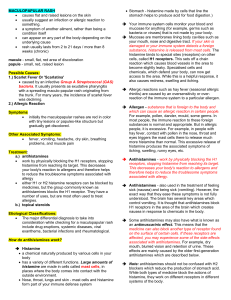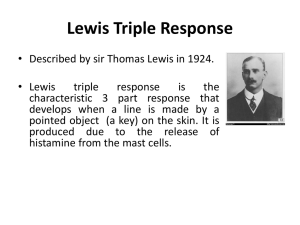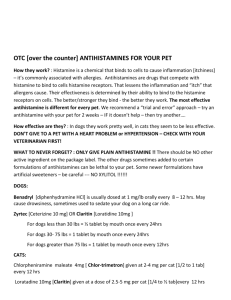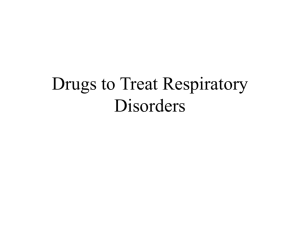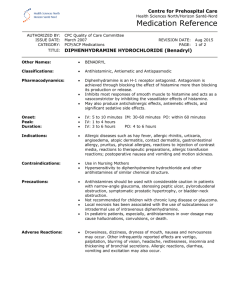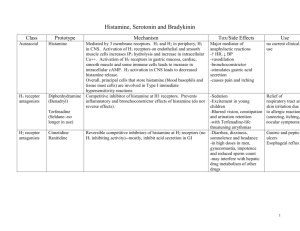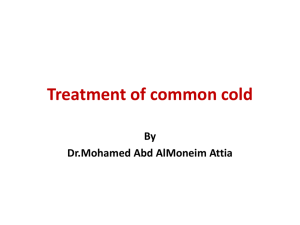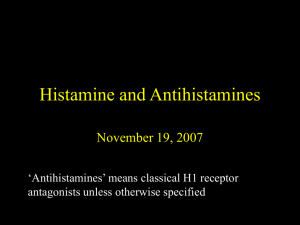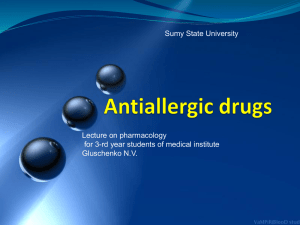allergic rhinitis
advertisement
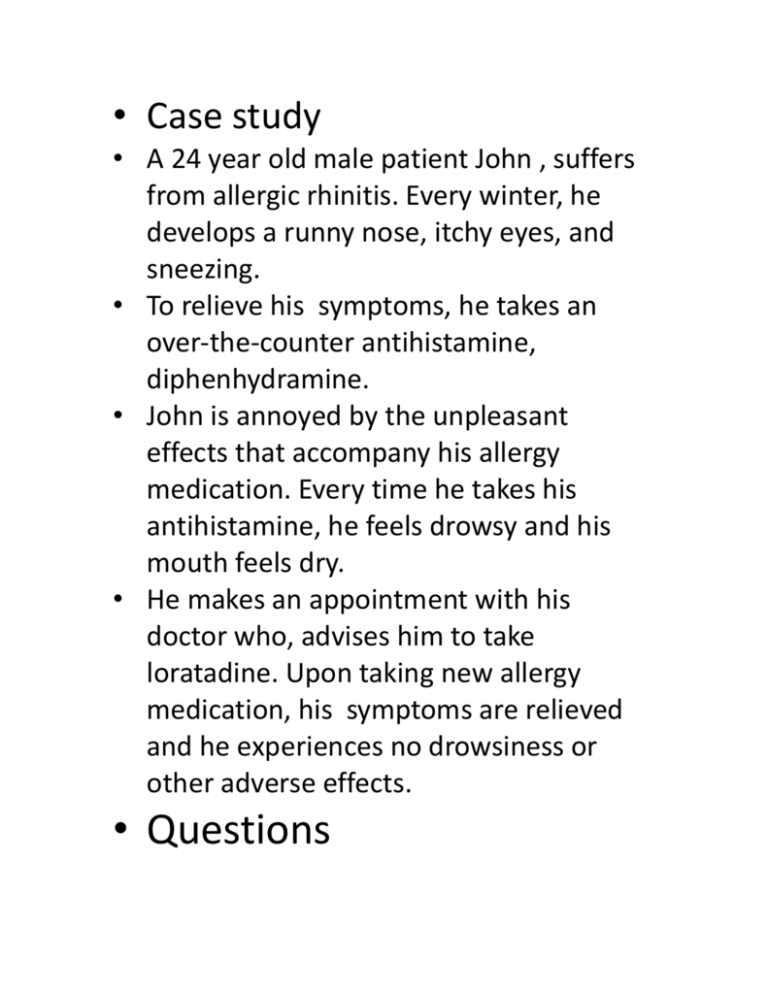
• Case study • A 24 year old male patient John , suffers from allergic rhinitis. Every winter, he develops a runny nose, itchy eyes, and sneezing. • To relieve his symptoms, he takes an over-the-counter antihistamine, diphenhydramine. • John is annoyed by the unpleasant effects that accompany his allergy medication. Every time he takes his antihistamine, he feels drowsy and his mouth feels dry. • He makes an appointment with his doctor who, advises him to take loratadine. Upon taking new allergy medication, his symptoms are relieved and he experiences no drowsiness or other adverse effects. • Questions • Why does John develop seasonal rhinitis? • Why does diphenhydramine relieve John`s symptoms? • Why does diphenhydramine cause drowsiness? • Why doesn't loratadine cause drowsiness? • Autacoids (Histamine & Antihistamine) • Prepared by • Dr Rupinder Kaur Hashmi • Conducted By • Dr Naser Ashraf Tadvi • Objectives • Describe the pharmacology of histamine & enumerate its related drugs. • Classify the generation and sub-group of Histamine-1(H1) antagonists. • Discuss the pharmacology of H1 Antihistaminics with emphasis on clinical uses, adverse drug reactions & interactions • Autacoids • Autos = self; Akos = remedy (Greek). • Secreted locally to increase or decrease the activity of nearby cells. • Includes – Histamine, Serotonin – Prostaglandins and Leukotrines – Cytokines • Synthesis of histamine • Mechanism of action • Four types of receptors– H1 , H2, H3 and H4. • All are seven transmembrane Gprotein coupled receptors. • Some wide actions are mediated by both (H1 and H2) receptors. • Mechanism of Action of Histamine • Histamine receptor subtypes • Actions of histamine • Actions of histamine (contd.) • Drugs that cause release of histamine • D-tubocurarine • Morphine • Adverse effects of histamine release • Itching, Urticaria • Flushing • Hypotension • Tachycardia • • • • • • • • • • • Bronchospasm Angioedema Wakefullness Increased acidity (Gastric acid secretion) Antihistamines: H1 receptor blocker First generation Second generation H1-Antinistaminics /First generation H1-Antinistaminics /second generation Therapeutic uses Allergic diseases – Rhinitis, urticaria, conjunctivitis. – Bronchial asthma – Anaphylaxis – Topical preparations• Levocabastine • Azelastine • Ketotifen • Olopatadine • uses: First Generation Antihistamines • • • • • • Insomnia Anxiety Motion sickness Nausea and vomiting Morning sickness Vertigo • Uses: second Generation Antihistamines • Allergies • Reduce symptoms of itching, sneezing • Rhinorrhea • Allergic conjunctivitis • Common Adverse Effects • • • • • Anticholinergic (Atropine-like) Blurred vision Dry mouth Tachycardia Urinary retention Dizziness • • Drowsiness Paradoxical excitement in infants and children • Overdose of Astemizole and Terfenadine may cause arrhythmias • • • • Contraindications Acute angle-closure glaucoma Hypersensitivity Urinary obstruction • Drug interactions • Terfenadine and astemizole – Ketoconazole – Macrolide antibiotics Lethal ventricular arrhythmias. Torsades de pointes Withdrawn from market • Grapefruit juice also inhibits CYP3A4. – Increased levels of antihistamines. • Answers • The IgE-mediated hypersensitivity reaction is responsible for initiation of certain inflammatory disorders, like allergic rhinitis . • John suffered from allergic rhinitis, with a runny nose, itchy eyes, and sneezing. • An environmental allergen, such as pollen, crosses the nasal epithelium and enters the underlying tissue. There, the allergen encounters previously sensitized mast cells and crosslinks IgE/Fc receptor complexes on the mast cell surface. • The mast cell degranulates and releases histamine, which binds to H1 receptors in the nasal mucosa and local tissues. • Answers • Stimulation of H1 receptors causes blood vessel dilation and ↑es vascular permeability, leading to edema. This swelling in the nasal mucosa is responsible for the nasal congestion experienced in allergic rhinitis. • The accompanying itching, sneezing, runny nose, etc result from the combined action of histamine and other inflammatory mediators, including kinins, prostaglandins etc. • These molecules initiate the hypersecretion and irritation characteristic of allergic rhinitis.
